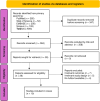The Role of Private Doctor and Private-Public Mix Systems in Tuberculosis Detection in Developing Countries: A Systematic Review
- PMID: 40655504
- PMCID: PMC12241745
- DOI: 10.18502/ijph.v54i6.18891
The Role of Private Doctor and Private-Public Mix Systems in Tuberculosis Detection in Developing Countries: A Systematic Review
Abstract
Background: Despite the significant efforts in tuberculosis (TB) management, TB case detection remains a challenge in developing countries. Traditional methods such as Directly Observed Treatment Short-course (DOTS) have often underperformed, necessitating the implementation of the public-private mix (PPM) strategy in recent decades. However, varied PPM models yielded varied results across different countries. Hence, this systematic review assesses the effectiveness of various PPM models and seeks innovative strategies to enhance TB detection.
Methods: A systematic search was conducted using PubMed, Scopus, Embase, and Web of Science up to August 2024. Studies evaluating the efficacy of PPM models on TB case detection in developing countries were pooled. From the initial 731 potential studies, a total of 10 studies were finally included in this systematic review.
Results: The review identified a variety of PPM interventions, including mass campaigns, mobile screening units, home-based tracking, and digital CXR examination. These approaches significantly raised tuberculosis detection rates compared to control groups or previous years. Notably, private sector involvement and novel approaches, such as application-based tracking in Vietnam and mobile vans equipped with digital X-rays in India, yielded favorable results. However, the variation in effectiveness rate underscored the importance of personalized approaches based on local contexts.
Conclusion: PPM models, especially those with innovative techniques, significantly enhance TB case detection. Scaling up and modifying these strategies to various country circumstances is critical to meeting global TB reduction targets.
Keywords: Developing countries; Public-private mix; Systematic review; Tuberculosis.
Copyright © 2025 Yuliandari et al. Published by Tehran University of Medical Sciences.
Similar articles
-
Public-private mix for tuberculosis care and control: a systematic review.Int J Infect Dis. 2015 May;34:20-32. doi: 10.1016/j.ijid.2015.02.015. Epub 2015 Feb 23. Int J Infect Dis. 2015. PMID: 25722284
-
Rapid molecular tests for tuberculosis and tuberculosis drug resistance: a qualitative evidence synthesis of recipient and provider views.Cochrane Database Syst Rev. 2022 Apr 26;4(4):CD014877. doi: 10.1002/14651858.CD014877.pub2. Cochrane Database Syst Rev. 2022. PMID: 35470432 Free PMC article.
-
Xpert® MTB/RIF assay for extrapulmonary tuberculosis and rifampicin resistance.Cochrane Database Syst Rev. 2018 Aug 27;8(8):CD012768. doi: 10.1002/14651858.CD012768.pub2. Cochrane Database Syst Rev. 2018. Update in: Cochrane Database Syst Rev. 2021 Jan 15;1:CD012768. doi: 10.1002/14651858.CD012768.pub3. PMID: 30148542 Free PMC article. Updated.
-
Systemic pharmacological treatments for chronic plaque psoriasis: a network meta-analysis.Cochrane Database Syst Rev. 2021 Apr 19;4(4):CD011535. doi: 10.1002/14651858.CD011535.pub4. Cochrane Database Syst Rev. 2021. Update in: Cochrane Database Syst Rev. 2022 May 23;5:CD011535. doi: 10.1002/14651858.CD011535.pub5. PMID: 33871055 Free PMC article. Updated.
-
Home treatment for mental health problems: a systematic review.Health Technol Assess. 2001;5(15):1-139. doi: 10.3310/hta5150. Health Technol Assess. 2001. PMID: 11532236
References
-
- Bagcchi S. (2023). WHO’s Global Tuberculosis Report 2022. Lancet Microbe, 4:e20. - PubMed
-
- Kangovi S, Mukherjee J, Bohmer R, et al. (2009). A Classification and Meta-analysis of Community-based Directly Observed Therapy Programs for Tuberculosis Treatment in Developing Countries. J Community Health, 34:506–13. - PubMed
-
- Khan AJ, Khowaja S, Khan FS, et al. (2012). Engaging the private sector to increase tuberculosis case detection: an impact evaluation study. Lancet Infect Dis,12:608–16. - PubMed
Publication types
LinkOut - more resources
Full Text Sources

